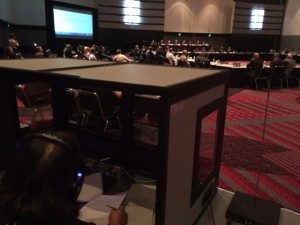
Prior to 1945, interpretation was a time-intensive endeavor, especially if a speech needed to be translated into multiple target languages. Limited to consecutive interpretation, the interpreter and the speaker would trade off, each waiting for the other to finish before continuing. As a result, large international meetings could extended in length by hours or days.
The turning point in interpretation techniques was a direct response to the International Military Tribunal’s (IMT) mandate that Nazi war criminals receive a “fair and expedient” trial. Each prisoner, under IMT’s direction, was entitled to a speedy legal process in their own language. What was more, representatives from each Member State of the Allied Forces executed the legal process. At any given time, judges, witnesses, defendants, prosecutors and reporters spoke a myriad of European languages in the same courtroom. Using traditional consecutive interpretation, a speedy trial would be impossible.
American Colonel Leon Dostert provided the solution to the problem by pioneering the use of simultaneous interpretation. Working with IBM and Commander Alfred Steer, Dostert created a team of interpreters who listened to the proceedings and translated it in real time into the microphones. His innovative process was based off of the technological precedent established by Edward Filene and later IBM, who created microphone systems for the League of Nations. With these early systems, speeches were translated in advance and read into the microphone as the speaker delivered their address. While this updated version of consecutive interpretation developed the necessary technology to deliver the translation to the ears of the listeners, it wasn’t adaptable enough for the spontaneous exchanges of a courtroom.
Using the sound system developed by Filene, Dostert trained his interpreters for an entirely new form of interpretation work. His team of over 100 interpreters allowed 12 interpreters to render Russian, English, German and French, with auxiliary interpreters for Polish and Yiddish available in the room. Because the interpreters worked at 60 words per minute, the speakers had to self-regulate their speaking speed. A yellow light would flash to warn the speaker to slow, and a red light flashed to tell the speaker to pause for the interpreters to catch up.
Because of the enormous number of German documents, the translation team was not able to keep up with the evidence presented. As a result, sight translation was standardized and used for the first time in a legal context, allowing interprets to read a document and provide a spoken translation on the spot.
Despite their innovations in simultaneous interpretation and sight translation, these innovated interpreters were often viewed as a “necessary evil” by members of the court. Listeners sometimes chose to remove their headsets, refusing to listen to the words of some defendants, or trip over the cords creating courtroom disruptions. Yet the system was ultimately so innovative and successful that many of the interpreters who honed their skills at the Nuremberg Trials were later hired by the U.N. when the new international body implemented the system.
What do you think of the historical origin of simultaneous interpretation and sight translation? Let us know your thoughts in the comments!






